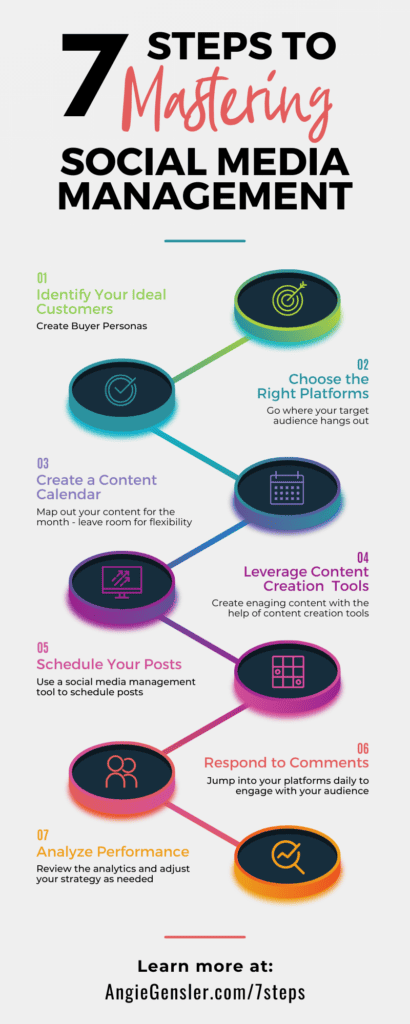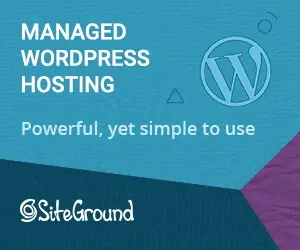Feeling overwhelmed by the ever-expanding world of social media?
Are you juggling multiple accounts, trying to keep up with the demands of each platform?
If so, you’re not alone.
Between the multitude of social media platforms, constantly shifting algorithms, and ever-evolving content trends, it’s no wonder that social media marketing can feel like an uphill battle.

But fear not – we’re here to help. In this article, we’ll provide you with a step-by-step guide to effortlessly handle your social media accounts and achieve success without the stress and hassle.
By following our seven-step plan, you’ll gain the skills and knowledge necessary to master social media management and achieve your business goals.
So, get ready to unleash the power of social media, build your audience, and grow your business. Let’s dive in!
*Please note this post may contain affiliate links, and I may earn a commission if you click them and make a purchase. This is, of course, at no cost to you. Please read my disclaimer for more information.
Step 1 – Identify Your Ideal Customer

To effectively leverage social media for your business, start by identifying your ideal customer.
Understanding who your target audience is will guide your strategy and help you create content that resonates with them.
To begin, take the time to gather as much information as possible about your target audience.
This includes demographics such as age, gender, location, and income level, but it also goes beyond that.
Consider their interests, values, and pain points. What motivates them? What challenges do they face?
By digging deep and developing a comprehensive understanding of your ideal customer, you’ll be better equipped to tailor your social media efforts to meet their needs.
One helpful approach is to create buyer personas, which are fictional representations of your target customers.
For help creating your buyer personas, watch the video training below.
These personas can help you visualize your audience and keep their preferences and goals top of mind as you create content and engage with them on social media.
Consider conducting surveys or interviews with existing customers to gather insights and refine your personas.
Once you have a clear picture of your ideal customer, it’s time to move on to the next step: choosing the right social media platforms.
Step 2 – Choose the Right Social Media Platforms

Each platform has its own unique audience and features, so it’s important to select the ones that align best with your target audience and business goals.
It’s important to understand where your target audience is spending their time online.
Are they active on Facebook, X, Instagram, LinkedIn, or perhaps a combination of these platforms?
Evaluating the demographics and behaviors of your potential customers will provide valuable insights to guide your decision-making process.
Consider the characteristics of each platform and how they align with your business goals.
For example, if you’re a visual-focused brand, platforms like Instagram or Pinterest may be a great fit.
If you’re targeting professionals or B2B audiences, LinkedIn might be the ideal platform to showcase your expertise and connect with industry leaders.
Also, take into account the type of content you plan to create and share.
Some platforms, like X, excel at short, concise updates, while others, like YouTube, are better suited for longer video content.
By understanding the strengths and limitations of each platform, you can ensure that your content will resonate with your audience and maximize engagement.
Remember that it’s better to focus on a few platforms where you can consistently create high-quality content rather than spreading yourself too thin across multiple platforms.
Start with one or two platforms that align best with your target audience and business goals, and then monitor their performance to determine where your efforts are paying off.
For help selecting the right platforms, read: How To Choose The Right Social Media Platforms For Your Business.
Once you’ve selected the best social media platforms to reach your ideal customer, you’re ready to move on to the next step.
Step 3 – Create a Content Calendar

When it comes to getting results on social media, consistency is key.
That’s why it’s crucial to create a content calendar that helps you stay organized and ensures you’re consistently delivering valuable content to your audience.
By planning and scheduling your posts in advance, you can maintain a consistent brand voice, provide value to your followers, and effectively promote your products or services.
A content calendar serves as a roadmap for your social media strategy.
It allows you to plan out your posts in advance, taking into consideration important dates, events, or promotions that are relevant to your business.
By mapping out your content in advance, you’ll have a clear vision of what to post and when to post it, ensuring that you’re not scrambling to come up with content on the fly.
When creating a content calendar, it’s helpful to start by determining the frequency of your posts.
Are you aiming for daily updates, multiple posts a week, or perhaps a more strategic approach with a few carefully crafted posts per month?
Consider your audience’s preferences and engagement levels to determine the optimal frequency for your business.
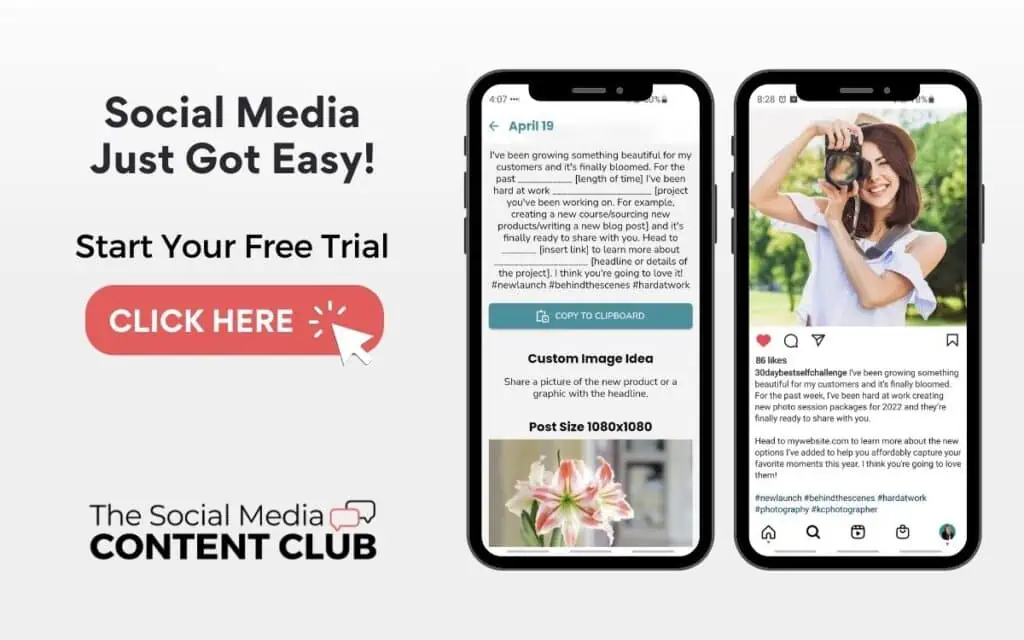
Once you have your frequency and platforms determined, it’s time to brainstorm content ideas.
Consider the different types of content that resonate with your audience, such as blog post links, videos, infographics, or user-generated content.
Brainstorm a variety of topics and formats that align with your brand and can provide value to your audience.
Next, it’s time to map out your content calendar. This can be done using a simple spreadsheet or a more sophisticated content management tool.
Start by assigning specific dates or time slots for your posts, along with the corresponding platforms and content format.
Make sure to leave room for flexibility, as you may want to capitalize on timely events or trending topics.
For more help creating your content calendar, read How to Create and Use a Social Media Content Calendar.
With your content calendar in place, you’ll be able to streamline your social media efforts and ensure you’re consistently delivering valuable content to your audience.
Step 4 – Leverage Content Creation Tools & Create Engaging Content

To streamline and simplify your social media efforts, you need to leverage content creation tools that will help you create engaging content that captivates your audience and drives results.
Content creation tools are invaluable when it comes to crafting high-quality posts that resonate with your target audience.
These tools can help you streamline your content creation process, saving you time and effort.
From graphic design platforms that allow you to easily create eye-catching visuals to done-for-you content services to video editing software that helps you produce professional-quality videos, there are a plethora of tools available to enhance your content creation game.
Two content creation tools we highly recommend are Canva and The Social Media Content Club.
Canva is a user-friendly graphic design platform that empowers even non-designers to create stunning visuals effortlessly.
With a vast library of templates, images, and design elements, you can customize your social media posts with a professional touch.
Whether it’s eye-catching graphics for promotions, engaging infographics, or attractive social media images, Canva is a versatile tool that simplifies the design process.
The Social Media Content Club is a service that provides a library of done-for-you content and AI tools to make creating and posting content to social media a breeze.
The Content Club provides a diverse range of pre-designed posts, captions, hashtag lists, professionally designed images, and daily video ideas.

When creating content for your social media platforms, it’s important to keep your audience in mind.
Understand their preferences, interests, and pain points, and tailor your content to meet their needs.
Engaging content is not only visually appealing but provides value to your audience.
This can be achieved through informative blog posts, entertaining videos, thought-provoking infographics, or engaging polls and quizzes that encourage interaction.
Incorporating storytelling and authenticity into your content can also help create a deeper connection with your audience.
Share behind-the-scenes glimpses of your business, highlight customer success stories, or showcase the people behind your brand.
By fostering a sense of community and building trust, you can establish yourself as a thought leader in your industry and create a loyal following.
If you need more help creating content, sign up for a free 7-day trial of the Social Media Content Club.
Now that you understand the importance of leveraging content creation tools and creating engaging content, it’s time to dive into step five.
Step 5 – Schedule Your Posts Using a Social Media Management Tool

As mentioned earlier, consistency is key when it comes to maintaining an active social media presence.
By scheduling your posts in advance, you can ensure that your content is consistently delivered to your audience, even when you’re unable to be online.
A social media management tool allows you to plan and schedule your posts across multiple platforms, saving you valuable time and effort.
One of the major advantages of using a social media management tool is the ability to plan your content calendar in advance.
Instead of scrambling for ideas and posting on a whim, you can strategically plan your posts to align with your overall marketing strategy.
This allows you to maintain a consistent brand voice and deliver relevant content to your audience.
Furthermore, a social media management tool provides you with the opportunity to optimize your posting schedule.
By analyzing your audience’s behavior and engagement patterns, you can identify the best times to post for maximum reach and engagement.
This data-driven approach ensures that your content is reaching the right people at the right time, increasing the likelihood of interaction and conversion.

In addition to scheduling your posts, some social media management tools also offer features such as post previews, content libraries, and post recycling.
Post previews allow you to see how your content will appear on different platforms, ensuring that your visuals and captions are optimized.
Content libraries allow you to save and organize your best-performing posts, making it easier to repurpose and reshare successful content.
Post recycling enables you to automatically repost evergreen content, extending its lifespan and reaching a larger audience.
By taking advantage of these scheduling features, you can streamline your social media management process and focus on other aspects of your business.
For help finding the right scheduling tool for your business needs, read Best Social Media Scheduling Tools for Small Business Owners.
With your posts scheduled and ready to go, you can now move on to step six.
Step 6 – Respond to Comments and Engage in Real Time

Social media is not a one-way street. It’s a dynamic and interactive platform that allows you to connect directly with your audience.
It’s called social media for a reason. So take some time each day to be social and engage in real-time with your audience.
When someone takes the time to comment on your post or ask a question, it’s important to respond in a timely manner.
This shows that you are actively listening and value their input.
Keep in mind that responding in a timely manner does not mean you need to live on your phone 24/7.
As a busy business owner, it’s important to set boundaries around the amount of time you spend on social media.
I recommend you set aside 10 – 30 minutes each day to jump on all your social media platforms and respond to comments and engage with your followers.
Responding to comments not only helps you engage with your audience on a personal level but also provides an opportunity for you to showcase your expertise and address any concerns.
By providing thoughtful and helpful responses, you can establish yourself as a trusted source and build credibility among your followers.
Remember, social media is about more than just broadcasting your messages – it’s about growing an audience and building genuine connections.
Step 7 – Analyze Performance and Adjust Your Strategy

While engaging with your audience is important, it’s equally essential to take a step back and evaluate the impact of your efforts.
By analyzing the performance of your social media marketing, you can gain valuable insights into what’s working and what needs improvement.
Start by reviewing the metrics that matter most to your business objectives.
Look at key metrics such as engagement rate, click-throughs, reach, and conversions.
These numbers will provide you with a clear picture of how effectively your social media efforts are at driving the desired outcomes.
Identify any patterns or trends in your data, such as which types of content or campaigns perform best, and use these insights to inform your future strategy.
Another important aspect of analyzing your social media performance is understanding your audience demographics and preferences.
Dive into the analytics provided by each social media platform to gain insights into who is engaging with your content.
Consider factors such as age, location, interests, and behavior. This information will help you tailor your content and messaging to better resonate with your target audience.
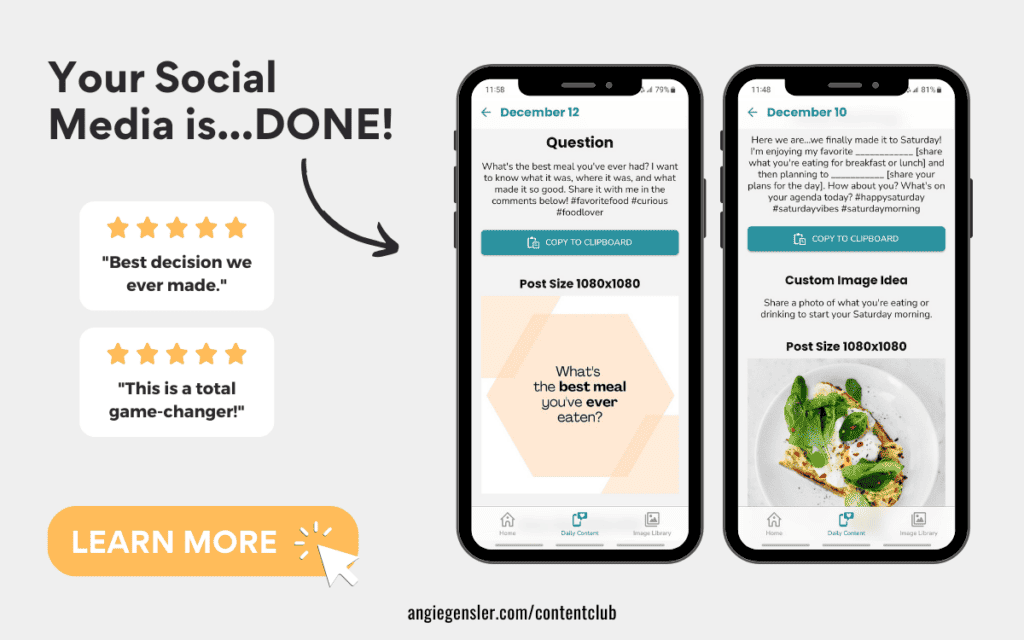
When analyzing your social media performance, don’t forget to assess the effectiveness of your posting schedule and frequency.
Experiment with different times and days to determine when your audience is most active and receptive.
By identifying the optimal posting times, you can increase the chances of reaching and engaging with your target audience.
Based on your analysis, it’s important to be willing to adjust your strategy.
Be open to trying new tactics, experimenting with different types of content, and refining your messaging based on what resonates with your audience.
Remember, social media is constantly evolving, and what works today may not work tomorrow. Stay agile and adapt your strategy to stay ahead of the curve.
Analyzing the performance of your social media efforts and adjusting your strategy accordingly is an ongoing process.
As you continue to iterate and refine your approach, you’ll become better equipped to achieve your business objectives through social media.
So roll up your sleeves, dive into the data, and seize the opportunity to optimize your social media strategy for even greater success.

Conclusion
Mastering social media is essential for business owners looking to build an audience and grow their business.
By following this step-by-step guide, you will be equipped with effective strategies and tools to ace your social media game.
Take the time to understand your ideal customer, choose the right platforms, create compelling content, schedule your posts strategically, and actively engage with your audience.
With dedication and consistency, your efforts will pay off, allowing you to hit your business goals.
Infographic
